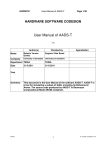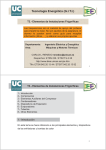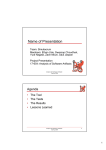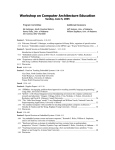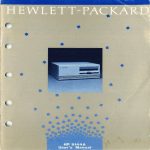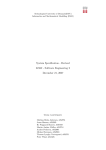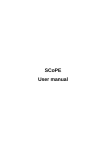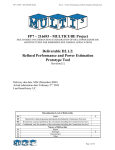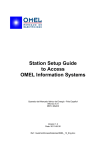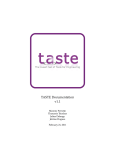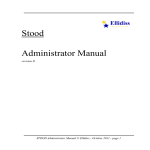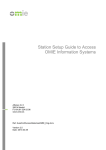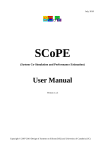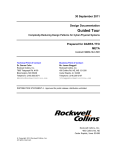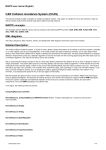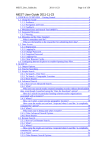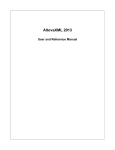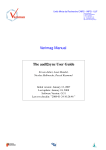Download see file
Transcript
User Manual of AADS SPICES Page 1/22 ITEA SPICES Support for Predictable Integration of mission Critical Embedded Systems User Manual of AADS 1.0 Author(s) Checked by Name Roberto Varona Gómez Eugenio Villar Bonet Company University of Cantabria University of Cantabria Department TEISA TEISA Date 7-7-2008 7-7-2008 Approbation Visa Summary This document is the User Manual of the software AADS. AADS is a tool for simulating a subset of AADL. Attention: la responsabilité des entreprises et des organismes ayant participé à l'élaboration de ce document ne peut en aucun cas être engagée en cas de dommages ou de pertes résultant de l'utilisation ou de l'exploitation des informations qui y sont contenues. Disclaimer: Contractors participating to this report shall incur no liability whatsoever for any damage or loss which may result from the use or exploitation of information and/or Rights contained in this report. 7/7/2008 1 © - ITEA SPICES - 2008 SPICES User Manual of AADS Page 2/22 Table of Contents 1 Preface ........................................................................................................................3 1.1 Table of versions ...................................................................................................3 1.2 Table of references and applicable documents .....................................................3 1.3 Acronyms and glossary .........................................................................................3 2 Subject ........................................................................................................................4 2.1 Purpose of the document ......................................................................................4 2.2 Editing particularities .............................................................................................4 2.2.1 Changes identification ....................................................................................4 2.2.2 Temporary editing ..........................................................................................4 2.3 Application scope ..................................................................................................4 2.4 Edition and evolution of the document...................................................................4 3 What makes AADS......................................................................................................5 4 Installation of AADS ....................................................................................................6 5 Use of AADS ...............................................................................................................7 6 Relation with SCoPE ...................................................................................................9 Annex I: Subset of AADL. ..................................................................................................12 Annex II: License. ..............................................................................................................13 II.1 GNU GENERAL PUBLIC LICENSE ........................................................................13 II.1.1 Preamble ..........................................................................................................13 II.1.2 TERMS AND CONDITIONS.............................................................................14 II.1.2.0 Definitions. ..................................................................................................14 II.1.2.1 Source Code. ..............................................................................................14 II.1.2.2 Basic Permissions.......................................................................................15 II.1.2.3 Protecting Users' Legal Rights From Anti-Circumvention Law. ...................15 II.1.2.4 Conveying Verbatim Copies........................................................................16 II.1.2.5 Conveying Modified Source Versions. ........................................................16 II.1.2.6 Conveying Non-Source Forms. ...................................................................16 II.1.2.7 Additional Terms. ........................................................................................18 II.1.2.8 Termination. ................................................................................................19 II.1.2.9 Acceptance Not Required for Having Copies. .............................................19 II.1.2.10 Automatic Licensing of Downstream Recipients. ......................................20 II.1.2.11 Patents. .....................................................................................................20 II.1.2.12 No Surrender of Others' Freedom. ............................................................21 II.1.2.13 Use with the GNU Affero General Public License. ....................................21 II.1.2.14 Revised Versions of this License. .............................................................22 II.1.2.15 Disclaimer of Warranty. .............................................................................22 II.1.2.16 Limitation of Liability. .................................................................................22 II.1.2.17 Interpretation of Sections 15 and 16. ........................................................22 7/7/2008 2 © - ITEA SPICES - 2008 User Manual of AADS SPICES 1 Preface 1.1 Table of versions Version 1.0 Date 7/7/2008 1.2 Page 3/22 Description & rationale of modifications First version Sections modified All Table of references and applicable documents Reference Title & edition Author or editor Year [1] Architecture analysis & design language (AADL), AS5506, v1.0 SAE AS2C 2004 [2] The Architecture Analysis & Design Language (AADL): An introduction. P. Feiler, D. Gluch, J. Hudak 2006 [3] POSIX de Tiempo Real. Michael González Harbour 2004 [4] An Extensible Open Source AADL Tool Environment (OSATE). SEI 2006 1.3 Acronyms and glossary Term Description AADL Architecture and Analysis Design Language AADS AADL Simulator ITEA Information Technology for European Advancement OSATE Open Source AADL Tool Environment POSIX Portable Operating System Interface SAX Simple API for XML SCoPE System Cosimulation & Performance Estimation SPICES Support for Predictable Integration of mission Critical Embedded Systems XML eXtensible Markup Language 7/7/2008 3 © - ITEA SPICES - 2008 SPICES User Manual of AADS 2 Subject 2.1 Purpose of the document Page 4/22 The purpose of this document is to describe the User Manual of the software tool AADS. This tool shall be able to provide a consistent manner, in accordance with a subset of the AADL standard, to simulate an AADL model using the tool SCoPE. This document specifies the way of using and the general characteristics of the tool AADS. 2.2 Editing particularities 2.2.1 Changes identification All the changes made since the previous publication are identified using the sign | in the left margin of each line holding a modification. 2.2.2 Temporary editing Special points are signalled like this: . ***temporary*** . ***incomplete*** . ***to be defined*** . ***to be confirmed*** 2.3 Application scope The application scope of this document is the ITEA SPICES project, more specifically Work Package 3 of the project, Component Execution Support, task T 3.4 of the Work Package. 2.4 Edition and evolution of the document The person responsible for the evolution of this document is Roberto Varona Gómez. This document will be in continuous evolution as required by the development of the tool AADS. 7/7/2008 4 © - ITEA SPICES - 2008 User Manual of AADS SPICES 3 Page 5/22 What makes AADS The tool AADS allows modeling a subset of AADL for purposes of implementation and simulation. The starting point of the simulator will be an AADL specification. This AADL specification must contain a minimum functionality described by means of the some AADL properties in order to enable a proper simulation of the model. The AADL model will be parsed by AADS and a model defined with POSIX / C++ and XML will be obtained. This model will be simulated in order to check if the AADL constraints are fulfilled. As the design process advances and the real functionality are attached to the software components using the corresponding source code, the value of these properties will be refined. These refined properties will be added to the AADL model and a new model will be generated by AADS to check if the constraints are still fulfilled. When the tool AADS is initiated it requests the name of two AADL XML files. One of these files is just the AADL model written in XML. The other is the result of an instantiation of a system implementation of a textual or object AADL model obtained with OSATE, a plug-in of the Eclipse platform used to process AADL models (see Fig. 1). These files are written in XML as they are easier to analyze using AADS because of the use of SAX. Once the XML files have been parsed by AADS, files written in C++ with the extensions .h and .cpp and one XML file are created. The number and names of the files created depend on the AADL model parsed. The C++ files use POSIX functions and the XML file must be as specified to be used by the tool SCoPE. Model AADL AADL XML File OSATE AADS Instantiated XML File POSIX / C++ Files SCoPE XML File Fig. 1. Relationship among OSATE, AADS and SCoPE. 7/7/2008 5 © - ITEA SPICES - 2008 SPICES 4 User Manual of AADS Page 6/22 Installation of AADS The tool AADS will be delivered as a plug-in of the Eclipse platform (see more about Eclipse in www.eclipse.org). This means that it will be necessary to install the Eclipse platform to run AADS as a button in the toolbar. Before installing AADS you must run Eclipse in the computer. Then you must choose the “File” item from the menu bar and the “New” and “Other…” to select with a double click the wizard “Plug-in Project” in the directory “Plug-in Development”. Using the wizard “New Plug-in Project” you must only write “AADS” in the box for “Project name”, click the button “Next” and finally the “Finish” one. If Eclipse is not in the “Plug-in Development perspective” you will be prompted to change it. It is better to change it for the installation. Then a new window of the AADS plug-in project appears with “Overview”, “Dependencies”, “Runtime”, “Extensions”, “Extension Points”, etc. sections. In the section “Extensions” you must click the “Add” button and when the window “New Extension” appears choose in the section “Extension Wizards” the simple “”Hello, World” action set”. You then click the “Next” button and can change the text “Hello, Eclipse world” in the “Message Box Text” with the text “AADS”. The next step is open “Windows Explorer” and overwrite the directory “AADS” recently created by Eclipse on your computer with the directory “AADS” delivered by the department TEISA of University of Cantabria. After this you must refresh information of Eclipse by clicking with the right button of your mouse over the directory “AADS” in the “Package Explorer” of Eclipse and clicking over “Refresh F5”. Finally click with the right button of your mouse over the directory “AADS” in the “Package Explorer” of Eclipse and click over “Properties”. When the window “Properties for AADS” appear click over “Run/Debug Settings” and choose the “Edit” button of the “Eclipse Application”. Once the window “Properties for Eclipse Application” is on, in the section “(x) = Arguments”, in the subsection “Working directory”, you can change the directory to “Other” and write for example “C:\AADL\model\cruise_control”. AADS takes the input files from this directory and leaves there the output files. 7/7/2008 6 © - ITEA SPICES - 2008 SPICES 5 User Manual of AADS Page 7/22 Use of AADS First of all the Eclipse platform must be initiated. After this, you must click with the right button of the mouse over the directory “AADS” in the view “Package Explorer”. You must choose “Run As” and then “1 Eclipse Application”. At this moment a new Eclipse application starts containing a button of AADS and an entry in the menu bar for AADS. When you click over this button or over the menu bar the tool AADS starts. The “Console” view of the Eclipse application arises showing the following message: AADS v1.2 AADL Simulator provided by University of Cantabria, Spain. www.teisa.unican.es Copyright (C) 2008 Roberto Varona Gómez This program comes with ABSOLUTELY NO WARRANTY; for details see http://www.gnu.org/licenses This is free software, and you are welcome to redistribute it under certain conditions. Please, write the name of the AADL XML file to parse NOT Instantiated (e. g. MySystem.aaxl): The user must write the name of the file XML not instantiated to be parsed like cruise.aaxl and press return. AADS parse this file and ask for the instantiated file written in XML to parse, for example cruise_Instance.aaxl. Parsing... ...end parsing. Please, write the name of the Instantiated AADL XML file to parse (e. g. MySystem_Instance.aaxl): It parses this file and produces some files written in C++ (files with extension .cpp and .h) complying with POSIX standard and a XML file. These files are in the working directory and can be used with the tool SCoPE. Parsing... instance name: cruise_control_Cruisecontrol_Generic_Instance ...end parsing. Begin POSIX and XML files... ... end POSIX and XML files. If the user writes wrong the name of the file to be parsed and the file does not exist, the tool AADS shows the following message and terminates. Sorry, the file cuise.aaxl does NOT exists. If the file exists but it is not the proper format, AADS will show the following messages (depending on the file) and will terminate. Exception1 org.xml.sax.SAXParseException: The root element is required in a well-formed document. ... Exception1 org.xml.sax.SAXParseException: The markup in the document preceding the root element must be well-formed. … 7/7/2008 7 © - ITEA SPICES - 2008 SPICES User Manual of AADS Page 8/22 java.lang.NullPointerException at parser.EscrituraFichero.HWComponent(EscrituraFichero.java:151) at parser.EscrituraFichero.GeneraXML(EscrituraFichero.java:101) at parser.EscrituraFichero.stringToFile(EscrituraFichero.java:64) at parser.Parseador.endDocument(Parseador.java:81) at org.apache.xerces.parsers.SAXParser.endDocument(SAXParser.java:1230) at org.apache.xerces.validators.common.XMLValidator.callEndDocument(XMLValidator.ja va:1146) at org.apache.xerces.framework.XMLDocumentScanner$EndOfInputDispatcher.dispatch(XML DocumentScanner.java:1499) at org.apache.xerces.framework.XMLDocumentScanner.parseSome(XMLDocumentScanner.java :381) at org.apache.xerces.framework.XMLParser.parse(XMLParser.java:1098) at org.apache.xerces.framework.XMLParser.parse(XMLParser.java:1139) at parser.Index.ParsearDocumento(Index.java:40)… … 7/7/2008 8 © - ITEA SPICES - 2008 SPICES 6 User Manual of AADS Page 9/22 Relation with SCoPE The tool AADS creates files written in C++ with the extensions .h and .cpp and one file written in XML. The number and names of the files created depends on the model AADL parsed. These files are used by SCoPE as we can see in Fig. 1 to simulate the model. Therefore, the structure that these files have and functions supported by SCoPE must be known for AADS. AADS only produces files to use with the tool SCoPE, so the relationship between AADS and SCoPE is total dependence on the first regarding the second. The XML file generated by AADS follows the 1.0 standard of W3C and uses UTF-8 encoding. This file is divided into four sections: HW_Platform, SW_Platform, Functionality and Allocation: HW_Platform is a description of the hardware platform. It is compound of HW_Component and HW_Architecture. HW_Component is a list of platform components with general attributes as category that is the type of hardware component, name the component name, speed which is the input or output data rate, and memSize that is the amount of memory that can be accesed from the rest of the system. HW_Architecture is a list of component instances describing the hardware architecture and is composed of component that is the name of the corresponding component, startAddr that indicates first the address in the memory map that corresponds to the component. SW_Platform describes the software platform elements as operative system, middleware and so on. It is compound of SW_Components and SW_Architecture. SW_Components is a list of software components with the name that indicates the component name, and type that indicates the type of component. In the SW_Architecture are the name of the instance, component that is the name of the software component, hw_resource that indicates the hardware resource were it runs, sw_resource that indicates the software resource were it runs. Functionality describes an executable component. The general attributes are name which is the component name, category that indicates the name of the main function of this task, and file that is the file where the task is coded. Allocation describes an instance of an executable component. It has the name which is the instance name, component which is the name of the ExecComponent and resource, the name of the resource where it will be computed. Before using SCoPE, it must be installed, compiled and linked on a Linux system or a virtual machine with Linux. For more information about SCope you can visit http://www.teisa.unican.es/scope or write an e-mail to [email protected] or a letter to SCope, GIM - TEISA, University of Cantabria, AV. Los Castros s/n, ETSIIT, 39005, Santander, Spain. So while AADS runs under Microsoft Windows, SCoPE runs under Linux; the files produced by AADS must be copied from one operative system to the other trough FTP, a shared directory or whatever. Once the files created by AADS are in the Linux system, a makefile must be created to compile and link these files with the ones of SCoPE. The result of the command make is an executable file. When executing this file the simulation starts and at the end of 7/7/2008 9 © - ITEA SPICES - 2008 SPICES User Manual of AADS Page 10/22 simulation SCoPE shows the number of thread and context switches, use of cpu, running time, etc. One important file of SCoPE that must be in the same directory as the files produced by AADS is sc_main.cpp. In this file you must define the name of the main function of the files .cpp (e. g. Mymain). The time (in milliseconds) during which SCoPE is simulating can be set in this file trough the sc_start function. The tool SCoPE provides the technology to perform MPSoC HW/SW co-simulation with NoC (Network on Chip). It gets results for exploring the design space to choose the right processors and HW/SW partition for embedded systems. It also allows the simulation of different nodes connected through a NoC in order to analyse the behaviour of large systems. Commonly, these tools are based on slow ISSs. The differentiating feature of this technique is that SCoPE gets the performance estimations at source code level. This level of abstraction allows the simulation time to be reduced significantly while maintaining good accuracy. SCoPE is a C++ library that extends, without modifying, the standard language SystemC to perform the co-simulation. On the one hand, it simulates C/C++ software code based on two different operating system interfaces (POSIX and MicroC/OS). On the other hand, it co-simulates these pieces of code with hardware described in SystemC. An engineer with this tool can simulate specific software over a custom platform and obtain estimations of: Number of thread and context switches, running time and use of CPU, instructions executed and cache misses, energy and power (of core and instruction cache). This library models the detailed behaviour of the RTOS including concurrency (among tasks in the same processor), parallelism (among tasks in different processors), scheduling and synchronization. Although the SystemC kernel executes processes following a non pre-emptive scheduling policy without priorities, SCoPE models preemption under different scheduling policies based on priorities. SCoPE integrates a POSIX based API that allows the execution of a large number of software applications that follows this standard. POSIX is the main operating system interface nowadays, but it is not the only one. Thus, SCoPE has been improved to support extensions for other types of interfaces. An example is the integration with the MicroC/OS interface. This is a demonstration of the scalability of the tool, in terms of software support. The design of embedded systems requires not only software handling but also hardware communication. For this reason SCoPE includes a set of more than a hundred driver facilities to implement this communication. One of the most extensively used operating systems in this sector is Linux, thus this driver facilities are based on the Linux kernel version 2.6. Furthermore, SCoPE is able to simulate the loading of kernel modules and the handling of hardware interruptions and their corresponding scheduling. SystemC is the language used for the modelling of the hardware platform due to the easiness of implementation (C++ extension) and its simulation kernel. For the purpose of simulating different platforms SCoPE incorporates some generic hardware modules: a bus based on TLM2 used for the communication with peripherals and the transmission of hardware interruptions, a DMA for copying large amounts of data, simple memory for the simulation of cache and DMA traffic, a hardware interface for simple custom hardware connection, a network interface that works as a net card for the NoC and an external 7/7/2008 10 © - ITEA SPICES - 2008 SPICES User Manual of AADS Page 11/22 network simulator to implement the NoC connected to SCoPE. System simulation comprises Multicomputation and Modular structure. Multicomputation: One of the advantages of this tool is the possibility of interconnection among independent nodes and simulating the interaction among them. Modular structure: Each RTOS component is an independent object that does not share any data with the others. Furthermore, each process is isolated from the rest of the system, thus a process with global variables can be replicated in many nodes without data collision problems. That is, each process has a separate memory space. 7/7/2008 11 © - ITEA SPICES - 2008 SPICES User Manual of AADS Page 12/22 Annex I: Subset of AADL. This annex lists alphabetically the subset of AADL implemented by AADS: bus data memory ports connections: data port event data port event port process processor properties: Assign_Byte_Time Base_Address Compute_Entrypoint Compute_Execution_Time Dispatch_Protocol Memory_Protocol Period Read_Time Source_Data_Size Source_Text UC::POSIX_Scheduling_Policy UC::Priority Word_Count Word_Size Write_Time system thread 7/7/2008 12 © - ITEA SPICES - 2008 SPICES User Manual of AADS Page 13/22 Annex II: License. AADS is distributed under license GNU GPL which is related in this section. II.1 GNU GENERAL PUBLIC LICENSE Version 3, 29 June 2007 Copyright © 2007 Free Software Foundation, Inc. <http://fsf.org/> Everyone is permitted to copy and distribute verbatim copies of this license document, but changing it is not allowed. II.1.1 Preamble The GNU General Public License is a free, copyleft license for software and other kinds of works. The licenses for most software and other practical works are designed to take away your freedom to share and change the works. By contrast, the GNU General Public License is intended to guarantee your freedom to share and change all versions of a program--to make sure it remains free software for all its users. We, the Free Software Foundation, use the GNU General Public License for most of our software; it applies also to any other work released this way by its authors. You can apply it to your programs, too. When we speak of free software, we are referring to freedom, not price. Our General Public Licenses are designed to make sure that you have the freedom to distribute copies of free software (and charge for them if you wish), that you receive source code or can get it if you want it, that you can change the software or use pieces of it in new free programs, and that you know you can do these things. To protect your rights, we need to prevent others from denying you these rights or asking you to surrender the rights. Therefore, you have certain responsibilities if you distribute copies of the software, or if you modify it: responsibilities to respect the freedom of others. For example, if you distribute copies of such a program, whether gratis or for a fee, you must pass on to the recipients the same freedoms that you received. You must make sure that they, too, receive or can get the source code. And you must show them these terms so they know their rights. Developers that use the GNU GPL protect your rights with two steps: (1) assert copyright on the software, and (2) offer you this License giving you legal permission to copy, distribute and/or modify it. For the developers' and authors' protection, the GPL clearly explains that there is no warranty for this free software. For both users' and authors' sake, the GPL requires that modified versions be marked as changed, so that their problems will not be attributed erroneously to authors of previous versions. Some devices are designed to deny users access to install or run modified versions of the software inside them, although the manufacturer can do so. This is fundamentally incompatible with the aim of protecting users' freedom to change the software. The systematic pattern of such abuse occurs in the area of products for individuals to use, which is precisely where it is most unacceptable. Therefore, we have designed this version 7/7/2008 13 © - ITEA SPICES - 2008 SPICES User Manual of AADS Page 14/22 of the GPL to prohibit the practice for those products. If such problems arise substantially in other domains, we stand ready to extend this provision to those domains in future versions of the GPL, as needed to protect the freedom of users. Finally, every program is threatened constantly by software patents. States should not allow patents to restrict development and use of software on general-purpose computers, but in those that do, we wish to avoid the special danger that patents applied to a free program could make it effectively proprietary. To prevent this, the GPL assures that patents cannot be used to render the program non-free. The precise terms and conditions for copying, distribution and modification follow. II.1.2 TERMS AND CONDITIONS II.1.2.0 Definitions. “This License” refers to version 3 of the GNU General Public License. “Copyright” also means copyright-like laws that apply to other kinds of works, such as semiconductor masks. “The Program” refers to any copyrightable work licensed under this License. Each licensee is addressed as “you”. “Licensees” and “recipients” may be individuals or organizations. To “modify” a work means to copy from or adapt all or part of the work in a fashion requiring copyright permission, other than the making of an exact copy. The resulting work is called a “modified version” of the earlier work or a work “based on” the earlier work. A “covered work” means either the unmodified Program or a work based on the Program. To “propagate” a work means to do anything with it that, without permission, would make you directly or secondarily liable for infringement under applicable copyright law, except executing it on a computer or modifying a private copy. Propagation includes copying, distribution (with or without modification), making available to the public, and in some countries other activities as well. To “convey” a work means any kind of propagation that enables other parties to make or receive copies. Mere interaction with a user through a computer network, with no transfer of a copy, is not conveying. An interactive user interface displays “Appropriate Legal Notices” to the extent that it includes a convenient and prominently visible feature that (1) displays an appropriate copyright notice, and (2) tells the user that there is no warranty for the work (except to the extent that warranties are provided), that licensees may convey the work under this License, and how to view a copy of this License. If the interface presents a list of user commands or options, such as a menu, a prominent item in the list meets this criterion. II.1.2.1 Source Code. The “source code” for a work means the preferred form of the work for making modifications to it. “Object code” means any non-source form of a work. A “Standard Interface” means an interface that either is an official standard defined by a recognized standards body, or, in the case of interfaces specified for a particular programming language, one that is widely used among developers working in that 7/7/2008 14 © - ITEA SPICES - 2008 SPICES User Manual of AADS Page 15/22 language. The “System Libraries” of an executable work include anything, other than the work as a whole, that (a) is included in the normal form of packaging a Major Component, but which is not part of that Major Component, and (b) serves only to enable use of the work with that Major Component, or to implement a Standard Interface for which an implementation is available to the public in source code form. A “Major Component”, in this context, means a major essential component (kernel, window system, and so on) of the specific operating system (if any) on which the executable work runs, or a compiler used to produce the work, or an object code interpreter used to run it. The “Corresponding Source” for a work in object code form means all the source code needed to generate, install, and (for an executable work) run the object code and to modify the work, including scripts to control those activities. However, it does not include the work's System Libraries, or general-purpose tools or generally available free programs which are used unmodified in performing those activities but which are not part of the work. For example, Corresponding Source includes interface definition files associated with source files for the work, and the source code for shared libraries and dynamically linked subprograms that the work is specifically designed to require, such as by intimate data communication or control flow between those subprograms and other parts of the work. The Corresponding Source need not include anything that users can regenerate automatically from other parts of the Corresponding Source. The Corresponding Source for a work in source code form is that same work. II.1.2.2 Basic Permissions. All rights granted under this License are granted for the term of copyright on the Program, and are irrevocable provided the stated conditions are met. This License explicitly affirms your unlimited permission to run the unmodified Program. The output from running a covered work is covered by this License only if the output, given its content, constitutes a covered work. This License acknowledges your rights of fair use or other equivalent, as provided by copyright law. You may make, run and propagate covered works that you do not convey, without conditions so long as your license otherwise remains in force. You may convey covered works to others for the sole purpose of having them make modifications exclusively for you, or provide you with facilities for running those works, provided that you comply with the terms of this License in conveying all material for which you do not control copyright. Those thus making or running the covered works for you must do so exclusively on your behalf, under your direction and control, on terms that prohibit them from making any copies of your copyrighted material outside their relationship with you. Conveying under any other circumstances is permitted solely under the conditions stated below. Sublicensing is not allowed; section 10 makes it unnecessary. II.1.2.3 Protecting Users' Legal Rights From Anti-Circumvention Law. No covered work shall be deemed part of an effective technological measure under any applicable law fulfilling obligations under article 11 of the WIPO copyright treaty adopted on 20 December 1996, or similar laws prohibiting or restricting circumvention of such 7/7/2008 15 © - ITEA SPICES - 2008 SPICES User Manual of AADS Page 16/22 measures. When you convey a covered work, you waive any legal power to forbid circumvention of technological measures to the extent such circumvention is effected by exercising rights under this License with respect to the covered work, and you disclaim any intention to limit operation or modification of the work as a means of enforcing, against the work's users, your or third parties' legal rights to forbid circumvention of technological measures. II.1.2.4 Conveying Verbatim Copies. You may convey verbatim copies of the Program's source code as you receive it, in any medium, provided that you conspicuously and appropriately publish on each copy an appropriate copyright notice; keep intact all notices stating that this License and any nonpermissive terms added in accord with section 7 apply to the code; keep intact all notices of the absence of any warranty; and give all recipients a copy of this License along with the Program. You may charge any price or no price for each copy that you convey, and you may offer support or warranty protection for a fee. II.1.2.5 Conveying Modified Source Versions. You may convey a work based on the Program, or the modifications to produce it from the Program, in the form of source code under the terms of section 4, provided that you also meet all of these conditions: a) The work must carry prominent notices stating that you modified it, and giving a relevant date. b) The work must carry prominent notices stating that it is released under this License and any conditions added under section 7. This requirement modifies the requirement in section 4 to “keep intact all notices”. c) You must license the entire work, as a whole, under this License to anyone who comes into possession of a copy. This License will therefore apply, along with any applicable section 7 additional terms, to the whole of the work, and all its parts, regardless of how they are packaged. This License gives no permission to license the work in any other way, but it does not invalidate such permission if you have separately received it. d) If the work has interactive user interfaces, each must display Appropriate Legal Notices; however, if the Program has interactive interfaces that do not display Appropriate Legal Notices, your work need not make them do so. A compilation of a covered work with other separate and independent works, which are not by their nature extensions of the covered work, and which are not combined with it such as to form a larger program, in or on a volume of a storage or distribution medium, is called an “aggregate” if the compilation and its resulting copyright are not used to limit the access or legal rights of the compilation's users beyond what the individual works permit. Inclusion of a covered work in an aggregate does not cause this License to apply to the other parts of the aggregate. II.1.2.6 Conveying Non-Source Forms. You may convey a covered work in object code form under the terms of sections 4 and 5, 7/7/2008 16 © - ITEA SPICES - 2008 SPICES User Manual of AADS Page 17/22 provided that you also convey the machine-readable Corresponding Source under the terms of this License, in one of these ways: a) Convey the object code in, or embodied in, a physical product (including a physical distribution medium), accompanied by the Corresponding Source fixed on a durable physical medium customarily used for software interchange. b) Convey the object code in, or embodied in, a physical product (including a physical distribution medium), accompanied by a written offer, valid for at least three years and valid for as long as you offer spare parts or customer support for that product model, to give anyone who possesses the object code either (1) a copy of the Corresponding Source for all the software in the product that is covered by this License, on a durable physical medium customarily used for software interchange, for a price no more than your reasonable cost of physically performing this conveying of source, or (2) access to copy the Corresponding Source from a network server at no charge. c) Convey individual copies of the object code with a copy of the written offer to provide the Corresponding Source. This alternative is allowed only occasionally and noncommercially, and only if you received the object code with such an offer, in accord with subsection 6b. d) Convey the object code by offering access from a designated place (gratis or for a charge), and offer equivalent access to the Corresponding Source in the same way through the same place at no further charge. You need not require recipients to copy the Corresponding Source along with the object code. If the place to copy the object code is a network server, the Corresponding Source may be on a different server (operated by you or a third party) that supports equivalent copying facilities, provided you maintain clear directions next to the object code saying where to find the Corresponding Source. Regardless of what server hosts the Corresponding Source, you remain obligated to ensure that it is available for as long as needed to satisfy these requirements. e) Convey the object code using peer-to-peer transmission, provided you inform other peers where the object code and Corresponding Source of the work are being offered to the general public at no charge under subsection 6d. A separable portion of the object code, whose source code is excluded from the Corresponding Source as a System Library, need not be included in conveying the object code work. A “User Product” is either (1) a “consumer product”, which means any tangible personal property which is normally used for personal, family, or household purposes, or (2) anything designed or sold for incorporation into a dwelling. In determining whether a product is a consumer product, doubtful cases shall be resolved in favor of coverage. For a particular product received by a particular user, “normally used” refers to a typical or common use of that class of product, regardless of the status of the particular user or of the way in which the particular user actually uses, or expects or is expected to use, the product. A product is a consumer product regardless of whether the product has substantial commercial, industrial or non-consumer uses, unless such uses represent the only significant mode of use of the product. “Installation Information” for a User Product means any methods, procedures, authorization keys, or other information required to install and execute modified versions of a covered work in that User Product from a modified version of its Corresponding Source. 7/7/2008 17 © - ITEA SPICES - 2008 SPICES User Manual of AADS Page 18/22 The information must suffice to ensure that the continued functioning of the modified object code is in no case prevented or interfered with solely because modification has been made. If you convey an object code work under this section in, or with, or specifically for use in, a User Product, and the conveying occurs as part of a transaction in which the right of possession and use of the User Product is transferred to the recipient in perpetuity or for a fixed term (regardless of how the transaction is characterized), the Corresponding Source conveyed under this section must be accompanied by the Installation Information. But this requirement does not apply if neither you nor any third party retains the ability to install modified object code on the User Product (for example, the work has been installed in ROM). The requirement to provide Installation Information does not include a requirement to continue to provide support service, warranty, or updates for a work that has been modified or installed by the recipient, or for the User Product in which it has been modified or installed. Access to a network may be denied when the modification itself materially and adversely affects the operation of the network or violates the rules and protocols for communication across the network. Corresponding Source conveyed, and Installation Information provided, in accord with this section must be in a format that is publicly documented (and with an implementation available to the public in source code form), and must require no special password or key for unpacking, reading or copying. II.1.2.7 Additional Terms. “Additional permissions” are terms that supplement the terms of this License by making exceptions from one or more of its conditions. Additional permissions that are applicable to the entire Program shall be treated as though they were included in this License, to the extent that they are valid under applicable law. If additional permissions apply only to part of the Program, that part may be used separately under those permissions, but the entire Program remains governed by this License without regard to the additional permissions. When you convey a copy of a covered work, you may at your option remove any additional permissions from that copy, or from any part of it. (Additional permissions may be written to require their own removal in certain cases when you modify the work.) You may place additional permissions on material, added by you to a covered work, for which you have or can give appropriate copyright permission. Notwithstanding any other provision of this License, for material you add to a covered work, you may (if authorized by the copyright holders of that material) supplement the terms of this License with terms: a) Disclaiming warranty or limiting liability differently from the terms of sections 15 and 16 of this License; or b) Requiring preservation of specified reasonable legal notices or author attributions in that material or in the Appropriate Legal Notices displayed by works containing it; or c) Prohibiting misrepresentation of the origin of that material, or requiring that modified versions of such material be marked in reasonable ways as different from the original version; or 7/7/2008 18 © - ITEA SPICES - 2008 SPICES User Manual of AADS Page 19/22 d) Limiting the use for publicity purposes of names of licensors or authors of the material; or e) Declining to grant rights under trademark law for use of some trade names, trademarks, or service marks; or f) Requiring indemnification of licensors and authors of that material by anyone who conveys the material (or modified versions of it) with contractual assumptions of liability to the recipient, for any liability that these contractual assumptions directly impose on those licensors and authors. All other non-permissive additional terms are considered “further restrictions” within the meaning of section 10. If the Program as you received it, or any part of it, contains a notice stating that it is governed by this License along with a term that is a further restriction, you may remove that term. If a license document contains a further restriction but permits relicensing or conveying under this License, you may add to a covered work material governed by the terms of that license document, provided that the further restriction does not survive such relicensing or conveying. If you add terms to a covered work in accord with this section, you must place, in the relevant source files, a statement of the additional terms that apply to those files, or a notice indicating where to find the applicable terms. Additional terms, permissive or non-permissive, may be stated in the form of a separately written license, or stated as exceptions; the above requirements apply either way. II.1.2.8 Termination. You may not propagate or modify a covered work except as expressly provided under this License. Any attempt otherwise to propagate or modify it is void, and will automatically terminate your rights under this License (including any patent licenses granted under the third paragraph of section 11). However, if you cease all violation of this License, then your license from a particular copyright holder is reinstated (a) provisionally, unless and until the copyright holder explicitly and finally terminates your license, and (b) permanently, if the copyright holder fails to notify you of the violation by some reasonable means prior to 60 days after the cessation. Moreover, your license from a particular copyright holder is reinstated permanently if the copyright holder notifies you of the violation by some reasonable means, this is the first time you have received notice of violation of this License (for any work) from that copyright holder, and you cure the violation prior to 30 days after your receipt of the notice. Termination of your rights under this section does not terminate the licenses of parties who have received copies or rights from you under this License. If your rights have been terminated and not permanently reinstated, you do not qualify to receive new licenses for the same material under section 10. II.1.2.9 Acceptance Not Required for Having Copies. You are not required to accept this License in order to receive or run a copy of the Program. Ancillary propagation of a covered work occurring solely as a consequence of using peer-to-peer transmission to receive a copy likewise does not require acceptance. 7/7/2008 19 © - ITEA SPICES - 2008 SPICES User Manual of AADS Page 20/22 However, nothing other than this License grants you permission to propagate or modify any covered work. These actions infringe copyright if you do not accept this License. Therefore, by modifying or propagating a covered work, you indicate your acceptance of this License to do so. II.1.2.10 Automatic Licensing of Downstream Recipients. Each time you convey a covered work, the recipient automatically receives a license from the original licensors, to run, modify and propagate that work, subject to this License. You are not responsible for enforcing compliance by third parties with this License. An “entity transaction” is a transaction transferring control of an organization, or substantially all assets of one, or subdividing an organization, or merging organizations. If propagation of a covered work results from an entity transaction, each party to that transaction who receives a copy of the work also receives whatever licenses to the work the party's predecessor in interest had or could give under the previous paragraph, plus a right to possession of the Corresponding Source of the work from the predecessor in interest, if the predecessor has it or can get it with reasonable efforts. You may not impose any further restrictions on the exercise of the rights granted or affirmed under this License. For example, you may not impose a license fee, royalty, or other charge for exercise of rights granted under this License, and you may not initiate litigation (including a cross-claim or counterclaim in a lawsuit) alleging that any patent claim is infringed by making, using, selling, offering for sale, or importing the Program or any portion of it. II.1.2.11 Patents. A “contributor” is a copyright holder who authorizes use under this License of the Program or a work on which the Program is based. The work thus licensed is called the contributor's “contributor version”. A contributor's “essential patent claims” are all patent claims owned or controlled by the contributor, whether already acquired or hereafter acquired, that would be infringed by some manner, permitted by this License, of making, using, or selling its contributor version, but do not include claims that would be infringed only as a consequence of further modification of the contributor version. For purposes of this definition, “control” includes the right to grant patent sublicenses in a manner consistent with the requirements of this License. Each contributor grants you a non-exclusive, worldwide, royalty-free patent license under the contributor's essential patent claims, to make, use, sell, offer for sale, import and otherwise run, modify and propagate the contents of its contributor version. In the following three paragraphs, a “patent license” is any express agreement or commitment, however denominated, not to enforce a patent (such as an express permission to practice a patent or covenant not to sue for patent infringement). To “grant” such a patent license to a party means to make such an agreement or commitment not to enforce a patent against the party. If you convey a covered work, knowingly relying on a patent license, and the Corresponding Source of the work is not available for anyone to copy, free of charge and under the terms of this License, through a publicly available network server or other readily 7/7/2008 20 © - ITEA SPICES - 2008 SPICES User Manual of AADS Page 21/22 accessible means, then you must either (1) cause the Corresponding Source to be so available, or (2) arrange to deprive yourself of the benefit of the patent license for this particular work, or (3) arrange, in a manner consistent with the requirements of this License, to extend the patent license to downstream recipients. “Knowingly relying” means you have actual knowledge that, but for the patent license, your conveying the covered work in a country, or your recipient's use of the covered work in a country, would infringe one or more identifiable patents in that country that you have reason to believe are valid. If, pursuant to or in connection with a single transaction or arrangement, you convey, or propagate by procuring conveyance of, a covered work, and grant a patent license to some of the parties receiving the covered work authorizing them to use, propagate, modify or convey a specific copy of the covered work, then the patent license you grant is automatically extended to all recipients of the covered work and works based on it. A patent license is “discriminatory” if it does not include within the scope of its coverage, prohibits the exercise of, or is conditioned on the non-exercise of one or more of the rights that are specifically granted under this License. You may not convey a covered work if you are a party to an arrangement with a third party that is in the business of distributing software, under which you make payment to the third party based on the extent of your activity of conveying the work, and under which the third party grants, to any of the parties who would receive the covered work from you, a discriminatory patent license (a) in connection with copies of the covered work conveyed by you (or copies made from those copies), or (b) primarily for and in connection with specific products or compilations that contain the covered work, unless you entered into that arrangement, or that patent license was granted, prior to 28 March 2007. Nothing in this License shall be construed as excluding or limiting any implied license or other defenses to infringement that may otherwise be available to you under applicable patent law. II.1.2.12 No Surrender of Others' Freedom. If conditions are imposed on you (whether by court order, agreement or otherwise) that contradict the conditions of this License, they do not excuse you from the conditions of this License. If you cannot convey a covered work so as to satisfy simultaneously your obligations under this License and any other pertinent obligations, then as a consequence you may not convey it at all. For example, if you agree to terms that obligate you to collect a royalty for further conveying from those to whom you convey the Program, the only way you could satisfy both those terms and this License would be to refrain entirely from conveying the Program. II.1.2.13 Use with the GNU Affero General Public License. Notwithstanding any other provision of this License, you have permission to link or combine any covered work with a work licensed under version 3 of the GNU Affero General Public License into a single combined work, and to convey the resulting work. The terms of this License will continue to apply to the part which is the covered work, but the special requirements of the GNU Affero General Public License, section 13, concerning interaction through a network will apply to the combination as such. 7/7/2008 21 © - ITEA SPICES - 2008 SPICES User Manual of AADS Page 22/22 II.1.2.14 Revised Versions of this License. The Free Software Foundation may publish revised and/or new versions of the GNU General Public License from time to time. Such new versions will be similar in spirit to the present version, but may differ in detail to address new problems or concerns. Each version is given a distinguishing version number. If the Program specifies that a certain numbered version of the GNU General Public License “or any later version” applies to it, you have the option of following the terms and conditions either of that numbered version or of any later version published by the Free Software Foundation. If the Program does not specify a version number of the GNU General Public License, you may choose any version ever published by the Free Software Foundation. If the Program specifies that a proxy can decide which future versions of the GNU General Public License can be used, that proxy's public statement of acceptance of a version permanently authorizes you to choose that version for the Program. Later license versions may give you additional or different permissions. However, no additional obligations are imposed on any author or copyright holder as a result of your choosing to follow a later version. II.1.2.15 Disclaimer of Warranty. THERE IS NO WARRANTY FOR THE PROGRAM, TO THE EXTENT PERMITTED BY APPLICABLE LAW. EXCEPT WHEN OTHERWISE STATED IN WRITING THE COPYRIGHT HOLDERS AND/OR OTHER PARTIES PROVIDE THE PROGRAM “AS IS” WITHOUT WARRANTY OF ANY KIND, EITHER EXPRESSED OR IMPLIED, INCLUDING, BUT NOT LIMITED TO, THE IMPLIED WARRANTIES OF MERCHANTABILITY AND FITNESS FOR A PARTICULAR PURPOSE. THE ENTIRE RISK AS TO THE QUALITY AND PERFORMANCE OF THE PROGRAM IS WITH YOU. SHOULD THE PROGRAM PROVE DEFECTIVE, YOU ASSUME THE COST OF ALL NECESSARY SERVICING, REPAIR OR CORRECTION. II.1.2.16 Limitation of Liability. IN NO EVENT UNLESS REQUIRED BY APPLICABLE LAW OR AGREED TO IN WRITING WILL ANY COPYRIGHT HOLDER, OR ANY OTHER PARTY WHO MODIFIES AND/OR CONVEYS THE PROGRAM AS PERMITTED ABOVE, BE LIABLE TO YOU FOR DAMAGES, INCLUDING ANY GENERAL, SPECIAL, INCIDENTAL OR CONSEQUENTIAL DAMAGES ARISING OUT OF THE USE OR INABILITY TO USE THE PROGRAM (INCLUDING BUT NOT LIMITED TO LOSS OF DATA OR DATA BEING RENDERED INACCURATE OR LOSSES SUSTAINED BY YOU OR THIRD PARTIES OR A FAILURE OF THE PROGRAM TO OPERATE WITH ANY OTHER PROGRAMS), EVEN IF SUCH HOLDER OR OTHER PARTY HAS BEEN ADVISED OF THE POSSIBILITY OF SUCH DAMAGES. II.1.2.17 Interpretation of Sections 15 and 16. If the disclaimer of warranty and limitation of liability provided above cannot be given local legal effect according to their terms, reviewing courts shall apply local law that most closely approximates an absolute waiver of all civil liability in connection with the Program, unless a warranty or assumption of liability accompanies a copy of the Program in return for a fee. 7/7/2008 22 © - ITEA SPICES - 2008






















